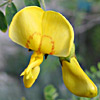Colutea istria (Bladder Senna) is a large and branched shrub. It reaches a height of up to 2 m. The branches are thin, with a brown-reddish bark. The leaf pinnates once into 4-6 pairs of broad ovate leaflets with entire margins and another single leaflet, grows at the tip of the leaf. There are two separate stipules at the base of the leaf. Each leaflet reaches a length of up to 15 mm and a width of up to 7 mm.
Bladder Senna blooms in March-April. The flower is beautiful, papilionaceous and yellow, large (up to 2 cm). The standard is round, emarginate at its head. There are 2 red circles at its base that touch each other (in another species, Colutea cilicica they are distanced from each other, and give the appearance of a pair of eyes). The wings are linear, inclined downwards. The keel is truncate. The ovary is pilose. The fruit is unique, beautiful and interesting: It is swollen and hollow, and looks like a short and fat sausage, with a length of 4-6 cm and a diameter of 2-3 cm. It hangs downwards on a long stalk. It has a reddish semi-transparent pericarp which turns silvery upon drying. The Hebrew name Karkash means intestine, and sausages were in the past prepared from cattle intestines. The seeds make sounds that resemble that of a baby’s rattle. The seeds are small and hard, kidney-shaped, brown, and are apparently a favorite of tiny Rhynchophorus beetles, since most of the seeds are infected and eaten by these beetles.
Bladder Senna grows on the heights of the Negev Mountains. Single individuals reach further north to the Lower Galilee (Karnei Hittin) and the southern Golan (Gamla). Some claim that these northern individuals originate from plants that were displaced by humans in the past. Its global distribution spreads over the Middle East.
The Colutea genus includes 25 species. Another species that is very similar to Bladder Senna, but with larger leaflets and flowers, is Colutea cilicica, which grows on Mount Hermon and further north.
Written by Mike Livne





